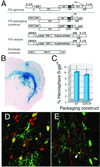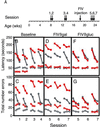Functional correction of established central nervous system deficits in an animal model of lysosomal storage disease with feline immunodeficiency virus-based vectors
- PMID: 11959904
- PMCID: PMC122929
- DOI: 10.1073/pnas.082011999
Functional correction of established central nervous system deficits in an animal model of lysosomal storage disease with feline immunodeficiency virus-based vectors
Abstract
Gene transfer vectors based on lentiviruses can transduce terminally differentiated cells in the brain; however, their ability to reverse established behavioral deficits in animal models of neurodegeneration has not previously been tested. When recombinant feline immunodeficiency virus (FIV)-based vectors expressing beta-glucuronidase were unilaterally injected into the striatum of adult beta-glucuronidase deficient [mucopolysaccharidosis type VII (MPS VII)] mice, an animal model of lysosomal storage disease, there was bihemispheric correction of the characteristic cellular pathology. Moreover, after the injection of FIV-based vectors expressing beta-glucuronidase into brains of beta-glucuronidase-deficient mice with established impairments in spatial learning and memory, there was dramatic recovery of behavioral function. Cognitive improvement resulting from expression of beta-glucuronidase was associated with alteration in expression of genes associated with neuronal plasticity. These data suggest that enzyme replacement to the MPS VII central nervous system goes beyond restoration of beta-glucuronidase activity in the lysosome, and imparts improvements in plasticity and spatial learning.
Figures




Comment in
-
Brain-directed gene therapy for lysosomal storage disease: going well beyond the blood- brain barrier.Proc Natl Acad Sci U S A. 2002 Apr 30;99(9):5760-2. doi: 10.1073/pnas.102175599. Proc Natl Acad Sci U S A. 2002. PMID: 11983877 Free PMC article. Review. No abstract available.
References
Publication types
MeSH terms
Substances
Grants and funding
LinkOut - more resources
Full Text Sources
Other Literature Sources

